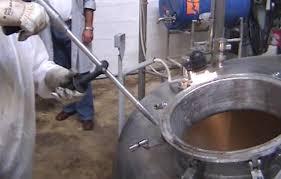How Dry Ice Blasting Revolutionizes Cleaning in Various Industries
Dry ice blasting is an innovative cleaning technology that has been gaining popularity across multiple sectors for its efficiency, eco-friendliness, and versatility. Unlike traditional cleaning methods that use water, chemicals, or abrasive materials, dry ice blasting utilizes solid carbon dioxide pellets to remove dirt, contaminants, and residues from surfaces without damaging the underlying material. But what exactly is dry ice blasting, how does it work, and why is it becoming a preferred method in industrial and commercial cleaning? This article explores these questions and highlights the benefits and applications of dry ice blasting.
What is Dry Ice Blasting?
Dry ice blasting is a cleaning process that uses compressed air to propel small dry ice pellets at high speeds onto a surface. These pellets, made of solid carbon dioxide (CO2), are colder than regular ice, with a temperature of around -78.5°C (-109.3°F). When the dry ice pellets strike a dirty or contaminated surface, they sublimate immediately upon impact, turning directly from solid to gas without leaving any residue behind.
The cleaning effect is achieved through a combination of thermal shock and kinetic energy. The extreme cold causes the contaminants to contract and become brittle, making them easier to dislodge. Simultaneously, the high-speed pellets physically impact the surface, breaking away dirt and grime. Because dry ice sublimates, no secondary waste is created, which makes cleanup simpler and faster compared to methods that leave behind water or abrasive particles.
How Does Dry Ice Blasting Work?
The dry ice blasting process involves several key steps:
- Preparation: The area to be cleaned is assessed for safety and accessibility. The dry ice blasting machine is set up, and the appropriate pressure and pellet size are selected based on the cleaning requirements.
- Blasting: Dry ice pellets are fed into the blasting machine, mixed with compressed air, and directed through a nozzle at the target surface. The pellets impact the surface, causing contaminants to crack and detach due to the cold and physical force.
- Sublimation and Evaporation: Upon hitting the surface, the dry ice pellets rapidly sublimate into carbon dioxide gas. This sudden change in state causes tiny explosions that help lift dirt and residues without damaging the substrate.
- Removal of Debris: Unlike other cleaning methods, dry ice blasting does not leave secondary waste like sand or water residue. The removed contaminants remain on the surface and can be easily wiped or vacuumed away.
Why Choose Dry Ice Blasting?
There are several reasons why industries and businesses are turning to dry ice blasting as their preferred cleaning technology:
Environmentally Friendly
Dry ice blasting is a sustainable cleaning method. It uses CO2 that is typically captured as a byproduct from other industrial processes, meaning it does not contribute to additional greenhouse gas emissions. Additionally, it eliminates the need for harmful solvents, chemicals, and large amounts of water, reducing the environmental footprint of cleaning operations.
Non-Abrasive and Safe for Delicate Surfaces
Unlike sandblasting or other abrasive techniques, dry ice blasting is gentle on surfaces. It can clean sensitive equipment, electrical components, and delicate materials without causing damage. This makes it ideal for applications in industries like aerospace, electronics, and automotive manufacturing where precision cleaning is critical.
Efficient and Time-Saving
Dry ice blasting can remove contaminants quickly and thoroughly, often eliminating the need for disassembly or manual scrubbing. It reduces downtime in industrial settings by enabling on-site cleaning without shutting down entire systems. Plus, since it produces no secondary waste, cleanup after blasting is minimal.
Versatile Applications
Dry ice blasting is used in a wide range of industries including food processing, pharmaceuticals, automotive, aerospace, printing, and manufacturing. It can clean everything from mold release agents on production lines to soot and carbon deposits in power plants.
Common Applications of Dry Ice Blasting
- Food Industry: Cleaning conveyor belts, ovens, and processing equipment without chemicals or water that could contaminate food products.
- Manufacturing: Removing oils, greases, and residues from machinery without dismantling parts.
- Automotive: Cleaning engine parts, molds, and assembly lines with precision.
- Historical Restoration: Gently removing paint, graffiti, or dirt from delicate surfaces like statues and monuments.
- Electronics: Cleaning circuit boards and electrical components without moisture or abrasion.
Where to Find Expert Dry Ice Blasting Services
If you are interested in exploring the benefits of dry ice blasting for your business, it is important to work with experienced professionals who can tailor the service to your specific needs. Top Dry Ice offers specialized dry ice blasting services and has a strong reputation for quality and reliability. You can find them and read reviews on their Google My Business profile here: Top Dry Ice on Google Maps.
Conclusion
Dry ice blasting is transforming the way industries approach cleaning by offering a faster, safer, and more environmentally responsible alternative to traditional methods. Its unique ability to clean effectively without damaging surfaces or producing secondary waste makes it suitable for a wide array of applications. Whether you manage a manufacturing plant, work in food processing, or require precision cleaning for delicate equipment, dry ice blasting is worth considering as part of your maintenance and cleaning strategy. Wit

